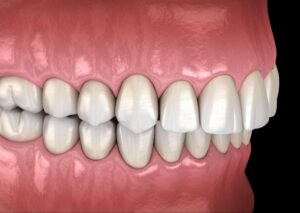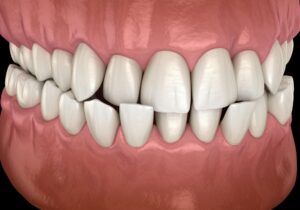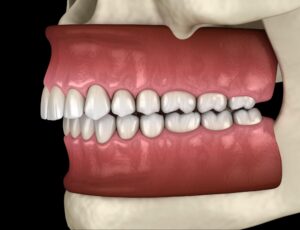Here at Sandifer Orthodontics, we’re proud to offer modern, high-quality treatment options to patients of all ages in Jackson, Brandon, and the surrounding communities. Treatments like braces and Invisalign can give you a beautiful smile and boost your confidence! Orthodontic treatment improves more than just cosmetic concerns, though.
Teeth in the wrong position can affect your ability to chew, speak, and sleep properly. These malocclusions can also increase the amount of wear and tear on the teeth, which can cause its own set of complications. If you’ve been experiencing any of these symptoms, you may wonder if orthodontic treatment can help. It can! To learn more about the most common oral issues and how to fix your bite with orthodontics, keep reading below.
Misalignment
When there is a misalignment in your mouth, the upper and lower teeth may not be able to meet comfortably. An abnormal bite like this can wear down tooth enamel, which causes chipping and thinning over time. As an experienced orthodontist, Dr. Camille Sandifer uses orthodontic appliances to move the upper jaw forward or backward into alignment. This will allow the teeth to meet, giving you a more functional bite. In more severe cases, we may recommend jaw surgery along with braces or clear aligners to achieve the best results.
Crowded or crooked teeth

Sometimes, a patient will have too many teeth for their jaw size to accommodate. In other cases, the teeth may fit but are crooked or turned. Whatever the reason, these issues can make it difficult to brush and floss effectively, giving food particles and bacteria a chance to build up. When plaque and tartar accumulate this way, it can increase the risk of developing gum disease. When overcrowding is the problem, we can remove one or more teeth to open up space in the mouth. We’ll then use braces or aligners to straighten the remaining teeth, giving you a beautiful, healthy smile. In borderline overcrowding, we do not have to remove teeth as Dr. Sandifer is able to make enough room with Damon System braces.
Excess spacing

Excess spacing in the midline, also known as midline diastema, is one of the most common issues for patients of all ages. A gap between the two front teeth is often caused by an overgrowth of the gum tissue that borders these teeth, but diastemata can occur for many reasons. This includes teeth that don’t erupt properly, the size of the jaw, and dysfunctional swallowing reflexes. We can use braces or aligners to close any gaps in the
teeth, improving the overall appearance and function of your smile.
Overbite

An overbite is when the upper teeth sit too far vertically over the lower teeth. When a deep overbite is present, the lower teeth recede so far behind the upper teeth that they bite into the roof of the mouth. This is detrimental to the teeth and the health of the jaw joints and can impact the shape and appearance of the face.
If you have a mild to moderate overbite, we can use braces or clear aligners to shift the upper teeth back towards the lower teeth. More severe overbites may be treated with orthodontics alone or require a combination of orthodontics and restorative dentistry. Correcting an overbite will improve the functionality of the teeth and the appearance of the smile.
Underbite

An underbite occurs when the bottom teeth protrude in front of the upper teeth. This type of bite misalignment can cause pain at the jaw joint, an unbalanced facial appearance, and uneven wear and tear on the teeth. Using braces, we can move the upper or lower teeth independently or both the upper and lower teeth together.
In severe cases of underbite, jaw surgery may be required in conjunction with orthodontics to correct the underbite. Treatment will help to relieve any pain and discomfort associated with the underbite. It can also make it easier to smile, eat, and breathe more normally.
Crossbite

A crossbite is when the lower teeth cover one or more upper teeth when you bite down. This irregular contact can happen in several places in the mouth and may cause headaches and jaw pain. It can also increase the chances of tooth decay, and abnormal teeth wear. More serious cases of crossbite can lead to tooth fractures, receding gums, and asymmetrical jaw growth in children.
Orthodontic appliances like clear or metal braces and Invisalign aligners can be very effective at treating various forms of crossbite. Along with aligning the upper and lower teeth, they can help us achieve some skeletal realignment. This is particularly effective when they’re used in conjunction with expanders, elastics, and additional appliances. It is very important to diagnose crossbites EARLY as this needs to be addressed before the fusion of the growth suture at the midline of the upper jaw. This is why 7 years old is the optimal age to begin seeing an orthodontist so facial asymmetries can be avoided altogether.
Open bite

With an open bite, the upper and lower front teeth don’t touch or close when smiling or chewing. Many open bites come from extended thumb sucking or pacifier use in childhood, which can cause the back teeth to continue to grow down while the front teeth are blocked by the fingers, tongue, or pacifier. . Another reason one may develop an openbite can be due to an irregular skeletal growth pattern that can be linked to an underlying airway issue. This is an important example of why orthodontists (specialists in orthodontics) need to be seeing children for semiannual “check or observation” visits to catch these issues that can be resolved earlier rather than later. Whatever the underlying reason for open bites, , they can also cause difficulty biting down and may result in a lisp and other speech issues.
There are multiple ways to treat openbites, but the longer they go untreated, the higher the possibility that surgery may be warranted for full correction. It is important to achieve early diagnosis and intervention during the growing years.
Excess overjet

When an excess overjet is present, the top front teeth will protrude far beyond the bottom front teeth. This results in the condition more commonly referred to as “buck teeth.” An overjet can be hereditary, but external factors like thumb sucking, prolonged use of a pacifier or bottle, or excessive tongue thrusting may also cause it.
An overjet can lead to speech issues, difficulty biting and chewing, and an inability to completely close the lips. It may also result in an irregular facial appearance. Orthodontic treatment with Sandifer Orthodontics can effectively treat overjets, diminishing the distance between the top and bottom teeth.
TMD
Temporomandibular disorder (TMD) is a condition that affects the temporomandibular joint (TMJ). We have two TMJs which are the joints that articulate with the base of the skull when the lower jaw moves. Sometimes, jaw or dental misalignment can put pressure on one or both TMJs. You may experience pain or tenderness in the face, jaw joint, or neck. There might also be pain in or around the ear when chewing or speaking and difficulty when yawning or opening the mouth wide. Braces or aligners can correctly align the upper and lower teeth to prevent irregular pressure on the temporomandibular joint, sometimes reducing or eliminating the symptoms associated with TMD. When jaws are misaligned, oral surgery may be needed in addition to orthodontic treatment. Although, it is advantageous to have a healthy bite to lower the possibility of TMD, some patients may still have to seek out treatment beyond an orthodontic specialist due to a myriad of issues that can lead to TMJ dysfunction.

Fix your bite and restore your smile with Sandifer Orthodontics
If you’ve been struggling with a bad bite, Sandifer Orthodontics is here to help! Our personalized treatment plans, cutting-edge technology, and innovative techniques will be able to bring your smile into perfect alignment. If you’d like to learn more about how orthodontics can improve your oral health, get in touch today to schedule a FREE consultation with Dr. Sandifer in Jackson or Brandon.
